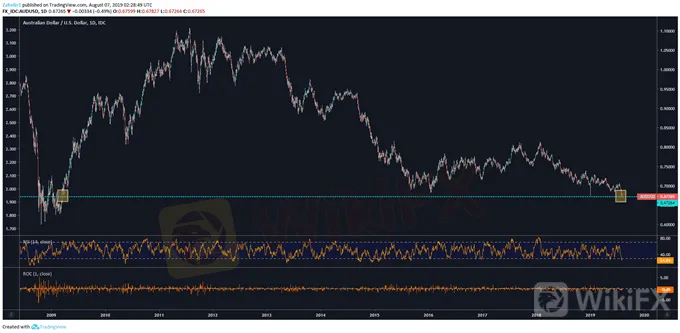简体中文
繁體中文
English
Pусский
日本語
ภาษาไทย
Tiếng Việt
Bahasa Indonesia
Español
हिन्दी
Filippiiniläinen
Français
Deutsch
Português
Türkçe
한국어
العربية
US Dollar Eyes Fed‘s Evans Speech After Bullard’s Commentary
Abstract:The US Dollar will be closely monitoring a speech from Chicago Fed President Charles Evans after St. Louis Fed President James Bullards neutral commentary.
FEDS EVANS COMMENTARY, US DOLLAR – TALKING POINTS
US Dollar traders eyeing Feds Evans speech
Feds Bullard yesterday radiated neutral tones
RBNZ slashes OCR by 50bp, spooked markets
See our free guide to learn how to use economic news in your trading strategy!
APAC RECAP
Early into Wednesdays Asia Pacific trading hours, the New Zealand and Australian Dollars were dealt a blow by an unexpectedly more-dovish Reserve Bank of New Zealand. The RBNZ cut the Overnight Cash Rate by 50bp, surprising market participants of whom the majority had priced in only 25bp cut. Excerpts from the monetary policy statement subsequently spooked markets and caused AUDUSD to plunge to 10-year lows.
US DOLLAR EYES CHICAGO FED PRESIDENT CHARLES EVANS COMMENTS
While the market reaction to St. Louis Fed President James Bullard‘s comments was fairly muted, the actual underlying message was quite telling. How he brushed off recession fears and the inversion of the yield curve suggests he is not overly worried about the current outlook. But that’s not to say hes happy about it. Tepid inflation and ongoing trade uncertainty remain key headwinds and he alluded to possible policy changes ahead.
He made it clear, however, that the Fed cannot respond to day-to-day trade developments and believes the central bank should not respond to knee-jerk reactions in the stock market. He also mentioned that the Fed has adjusted to trade uncertainty. This echoes Chairman Jerome Powells comments at the most recent FOMC meeting where he mentioned that the rate cut was serving as an insurance against future downside risks.
Markets will now be turning their attention to Chicago Fed President Charles Evans‘ media breakfast event. It will be interesting to see whether Mr. Evans’ tones will echo Mr. Bullards neutrality. If so, equity markets may express some panic from the idea that the prospect of lower borrowing costs may not be coming as soon as they would hope, much like they did at the most recent FOMC rate decision.
CHART OF THE DAY: AUDUSD REACHES 10-YEAR LOWS AFTER RBNZ SPOOKED MARKETS

Disclaimer:
The views in this article only represent the author's personal views, and do not constitute investment advice on this platform. This platform does not guarantee the accuracy, completeness and timeliness of the information in the article, and will not be liable for any loss caused by the use of or reliance on the information in the article.
Read more

Key Economic Calendar Events for This Week (August 5-9, 2024)
This week's economic events include: Japan's Monetary Policy Minutes and U.S. Services PMI on Monday, impacting JPY and USD. Tuesday's RBA Interest Rate Decision affects AUD, with German Factory Orders influencing EUR. Wednesday sees German Industrial Production and U.S. Crude Inventories impacting EUR and USD. Thursday: RBA Governor speaks, with U.S. Jobless Claims. Friday: China's CPI and Canada's Unemployment Rate affect CNY and CAD.

Anticipating the Nonfarm Payroll Report
As we approach the Nonfarm Payroll (NFP) report on August 2, 2024, market participants are keenly observing the data for insights into the U.S. labor market. The report is expected to show an increase of 194,000 to 206,000 jobs for July, indicating modest growth. This suggests potential softening in the labor market. A weaker-than-expected report could prompt the Fed to consider rate cuts, influencing the USD. Major currency pairs and gold prices will likely see volatility around the NFP release

High Volatility Economic Events for This Week (GMT+8)
This week, key economic events expected to generate high volatility include China's Q2 GDP and retail sales data, impacting CNY. The US will release Core Retail Sales and Philadelphia Fed Manufacturing Index, affecting USD. The UK's CPI data will influence GBP, and the ECB Interest Rate Decision and Press Conference will impact EUR. These events will drive significant market movements due to their influence on monetary policy and economic outlooks.

Global Market Insights: Key Events and Economic Analysis Part 2
This week's global market analysis covers significant movements and events. Fed Chairman Powell's cautious stance on interest rates impacts the USD. TSMC benefits from Samsung's strike. Geopolitical tensions rise with Putin's diplomacy. PBOC plans bond sales to stabilize CNY. Key economic events include Core CPI, PPI, and Michigan Consumer Sentiment for the USA, and GDP data for the UK. These factors influence currency movements and market sentiment globally.
WikiFX Broker
Latest News
CySEC Warns Against Unauthorized Investment Firms in Cyprus
Why Even the Highly Educated Fall Victim to Investment Scams?
Warning Against Globalmarketsbull & Cryptclubmarket
Dukascopy Bank Expands Trading Account Base Currencies
UK Sets Stage for Stablecoin Regulation and Staking Exemption
Axi Bids AUD 52M to Acquire Low-Cost Broker SelfWealth, Outbidding Competitor Bell Financial
Crypto Influencer's Body Found Months After Kidnapping
STARTRADER Issues Alerts on Fake Sites and Unauthorized Apps
Italy’s CONSOB Blocks Seven Unregistered Financial Websites
Bitfinex Hacker Ilya Lichtenstein Sentenced to 5 Years in Prison
Currency Calculator


